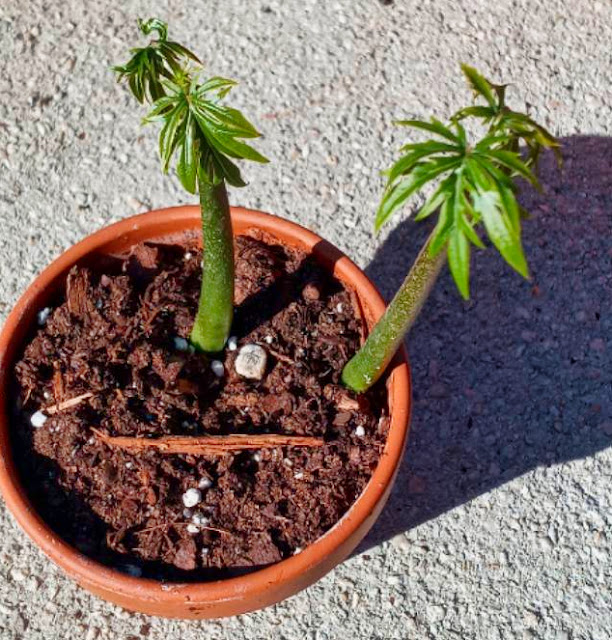Jatropha is an evergreen shrub or small tree with stunning flowers that attracts butterflies and hummingbirds to a Florida garden. The species is native to Mexico and the Caribbean but has become naturalized in Florida. Because it is very drought tolerant it is ideal for the Florida garden. There are two species of Jatropha that now grow quite well in Central and South Florida, Jatropha integerrima (sometimes called Peregrina) and Jatropha multifida (called Coral Bush).
Follow Phillip
| In Florida Zebra Longwing butterflies are especially drawn to Jatropha species. |
Is Jatropha Poisonous?
Yes. All parts of Jatropha are poisonous when ingested. All parts of the plant are poisonous but seeds have the highest concentration of ricin and thus are very poisonous. The adverse effects following consumption of seeds include vomiting, diarrhea, abdominal pain and burning sensation in the throat. For more on the poisonous aspect of these plants read Jatropha Poisoning in Children for research on the subject from India.
 |
| A large Jatropha integerrima at a South Florida nursery |
Jatropha is a tropical evergreen that has slender stems and multiple trunks. Jatropha integerrima plants can reach about 15 feet tall and have an equal spread when left unpruned. They are cold intolerant. Jatropha multifida plants are a usually a bit smaller (10-12 feet) and have a wider range, having successfully naturalized in Central Florida as far north as Lake George.
| Zebra Longwing on Coral Bush (Jatropha multifida) |
Jatropha integerrima is native to Cuba and the West Indies and is sometimes called peregrina, spicy Jatropha, or fire-cracker. The individual flowers on this species are star-shaped and generally red, although a pink-flowered variety exists. Flowers are 1-inch wide and are produced year-round in beautiful clusters that are held upright above the lobed leaves. Some of the butterflies you may see enjoying this plant include monarchs, swallowtails, and zebra longwings.
 |
| Jatropha multifida seed pods will turn yellow when ripe. |
Jatropha multifida, commonly called coral plant, is native to Mexico. This species has flat circles of coral-pink flowers and distinctly tropical-looking foliage that is deeply dissected and fan shaped. Coral plant is a bit more cold tolerant than peregrina and is a favorite of the Florida Zebra Longwing butterfly.
 |
| A hedge of Coral Bush, South Florida |
While these two species are not an invasive problem in Florida, there are some Jatropha species that are invasive in Florida. The UF/IFAS Assessment of Non-Native Plants in Florida’s Natural Areas has labeled Jatropha gossypiifolia and Jatropha curcas as invasive plants that should not be planted.
 |
| Jatropha gossypiifolia or "the belly-ache plant" should not be planted. |
These two species look nothing like the species featured here except that they produce similar nuts (You may have heard of J. curcas; sometimes proposed as source for biodiesel fuel production.) J. gossypiifolia goes by the ominous colloquial name "Belly-ache plant" indicating what might happen if you ingest any of the plant.
 |
| In summer its hard to find a Coral Bush without many Zebra Longwings nearby. For butterfly lovers, this is an excellent, drought-tolerant species. |
Once established, J. integerrima and J. multifida are both low maintenance and drought tolerant. Jatropha plants need well-drained soil, and while they can handle partial shade to full sun, they will flower best in areas with full sun. This plant is not salt tolerant. Frosts and freezes will damage Jatropha, but they usually recover quickly.
Jatropha tolerate pruning well, which gives you options when it comes to the form of your plant. You can let it grow naturally into an interesting multi-trunked tree, or with some pruning, it can be trained into a fabulous espalier, shrub, or single-trunked tree. Take care when pruning Jatropha plants, as the milky sap can irritate sensitive skin. The versatility of these plants is not limited to your pruning skills—Jatropha can actually work quite well in a large container on a porch or patio.
Jatropha Propagation
 |
| Jatropha seeds with other species for comparison |
 |
| Jatropha do very well in small pots under challenging conditions. |
Propagation is easy. Seeds will yellow on the plant then fall off when they are ready to sprout. Either stick them in a pot of place where you want them to grow. Each seed pod usually produces 3 Jatropha plants.



No comments:
Post a Comment